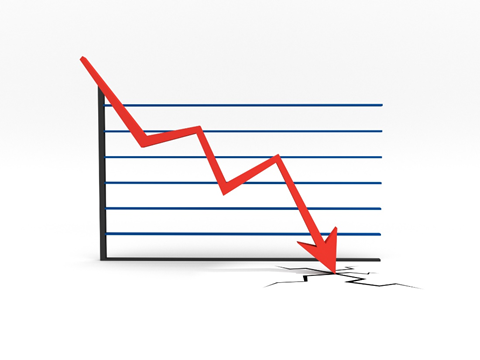What do you understand by the term Negative Return?
A negative return refers to any financial loss incurred by an investor from the money invested in a stock, project, business, or other financial instruments over a specific period. A negative return occurs when the return on an investor's investment in any business or project is less than the total amount invested. Noticeably, a negative return can either mean a net loss from all your investments/businesses or a loss on any particular investment or business. A negative return for a business is also known as a negative return on equity.
A negative return on securities means a decrease in the value of securities purchased by an investor with the belief that their value will appreciate over time. Besides, a business will see a negative return if it cannot generate enough revenues to meet its expenses. If the companies finance projects by utilising debt financing, then the return received from these investments should be greater than the interest rate on loan. Consistent negative returns can lead to a decrease in the share price of a business and can also lead to bankruptcy.
Summary
- A negative return refers to any financial loss incurred by an investor from the money invested in a stock, project, business or other financial instruments over a specific period.
- Constant negative returns can lead to a decrease in the share price of a business and can also lead to bankruptcy.
- A negative return on securities means a decrease in the value of securities purchased by an investor.
-
Negative returns can also result from projects that companies invest in by utilising debt financing.
Frequently Asked Questions
What is a negative return?
What does Negative Return in businesses mean? Can continuous Negative Return lead to bankruptcy?
Investors mostly rely on either fundamental or technical research to allocate capital for those securities they think will appreciate. Then, the final allocations are made based on the understanding of an investor. If the securities experience an increase in value, the investors will receive a positive return. However, if the value of the securities decreases, it will result in a loss; hence, the investors will receive a negative return on their investments. Portfolio losses can be offset against the capital gains to reduce the capital gains tax. Return on investment is a financial ratio commonly used to evaluate returns from an investment for an investor.

Image Source: © Andreypopov | Megapixl.com
Negative Returns in business
Negative returns in business denote the gain or loss experienced by a business for a particular period. For instance, a company will experience a negative return if it generates $40,000 in revenue but had $60,000 as its costs.
At the beginning or early phase, some businesses witness a negative return due to the amount of capital the investors need to put into the business to get it off the ground initially. If an excessive amount of money is spent in a business without bringing the revenue, it will lose.
New businesses take time to get established, so they do not make profits in the initial years.
Investors will continue with their investments in a company if they feel that the company has the required potential to convert its negative return into a positive return and generate high profits, sales, and turnover. On the other hand, investors may lose their faith in a company if it lacks a solid business plan and continuously witnesses negative returns. This will decrease the company’s share price and value, and it will become challenging to obtain financing. The company may also become bankrupt due to continuous negative returns.
Negative Returns on projects
Negative returns can also result from projects that companies invest in by utilising debt financing. For instance, a company may borrow money to expand its business and purchase new machinery. However, suppose the interest rate on loan availed by the company to buy new machinery is higher than the returns it is receiving from the new purchase. In that case, the company will see a negative return on this capital investment.
What can be an example of a Negative Return in stocks?
Suppose Patrick received $2,000 as a prize and decides to invest that amount in the stock market. So, he finds out a little about the stock market through research. At last, he decides to invest an equal amount of money in two stocks. The stocks are from two companies: Company ABC and Company XYZ. Patrick purchases each stock for $10,00.

Image Source: © Bon4ire | Megapixl.com
After a year, Patrick checks his portfolio. He realises that Company ABC has appreciated to $1100 while Company XYZ has depreciated to $700. While Patrick has a positive return on Company ABC he experiences a negative return on Company XYZ. Here, Parick’s overall portfolio will have a negative return of $200. The invested value was $2,000, whereas the current value is $1,800.
These constitute unrealised gains and losses, and Patrick can either sell these stocks or continue holding them. Furthermore, if Patrick sells the two stocks, the loss on Company XYZ can be offset against the capital gains of company ABC, reducing his capital gains tax.
Source:
Which factors can cause the Rate of Return to be negative?
Several factors can cause a negative rate of return for an investment. Some critical factors include poor company performance, economic turmoil in a country, inflation, absence of a proper business plan, etc. The amount that particular investment gains or losses over a specified period is termed the rate of return.
For instance, if an individual buys a mutual fund for $10,000. Then, after a year, the fund appreciates to $12,000. This means that the rate of return for that year is 20%. It is believed that hyperinflation can also cause a negative rate of return while inflation can exacerbate it. Furthermore, even a single unpleasant economic statistic can have a huge impact on returns from investments. It can cause millions of investors to see negative rates of return for different periods. Similarly, the actual rate of return comes into the picture when one talks about the impact of inflation on an investor’s rate of return. An investment that earlier had a positive rate of return in dollars will have a negative real rate of return if the inflation is more than the investment's gain. For instance, a stock that experiences a profit of 10% in a year when inflation rises to 8% will have a real rate of return of 2%. This suggests that though the investor has 10% more money, the purchasing power has increased by only 2%.
 Please wait processing your request...
Please wait processing your request...